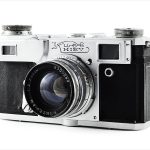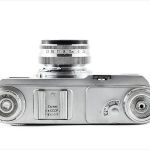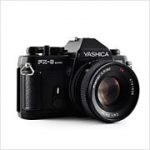Kiev-4A Specifications
| Manufacturer: | Zavod Arsenal |
| Origin: | Soviet Union |
| (modern day Ukraine) | |
| Made in: | Kiev, USSR |
| (modern day Ukraine) | |
| Introduced: | 1956 |
| Type: | Rangefinder |
| Lens Mount: | Contax RF Mount |
| Format: | 135 Film |
| Dimensions: | 14 x 8.4 x 3.8 cm (body only) |
| 14 x 8.4 x 6.7 cm (with lens) |
Kiev-4A Overview
The Kiev-4A is one of several professional grade 35mm “Kiev” rangefinders produced by the Arsenal Factory, one of the oldest and most famous industrial factories in the former Soviet Union and modern day Ukraine. After the defeat of Germany in World War II, most of the surviving equipment and schematics from the Zeiss factory were removed from Dresden and taken to the newly reestablished Arsenal Factory in Kiev. Although primarily a military factory, Arsenal also produced civilian products including copies of cameras made by other manufacturers such as Zeiss Ikon, Hasselblad, and Nikon.
The Kiev-4A and its siblings are relatively high quality copies of the famous Zeiss Ikon Contax simplified for mass production at the Arsenal Factory. Like its German counterpart, the Kiev-4A utilizes the hybrid Contax RF Mount which was also copied by the Soviets. The camera left the factory with a Jupiter-8M 50mm f/2 lens but is compatible with all other Contax RF Mount lenses. Paired with the lens is a curtain shutter capable of speeds ranging from 1/2 to 1/1250 seconds and Bulb which can be set by lifting the crown of the frame advance knob on the user’s right hand side of the top plate and fired by depressing the shutter button at its center. Other features of the top plate are (going from right to left starting from the shutter button) a manually set frame counter, cold shoe, and film rewind knob with film speed indicator.
One of the more unusual features of the Kiev rangefinder (which was copied from the Contax) is the focusing cog on top of the rangefinder assembly above the self-timer lever. In order to focus, the focus lock must first be disengaged either by pressing the silver tab behind the focusing cog or shifting the metal pin at the 2:00 mark on the lens mount by the flash sync socket. Once unlocked, users can adjust focus either by turning the focusing cog with their right index or middle finger or rotating the lens barrel with their left hand.
Although I had wanted a Kiev rangefinder for many years, I didn’t have one in my collection until my brother gave me this fantastic 4A as a surprise birthday gift. It’s in perfect working order and very good cosmetic condition. Also, as a strange bonus of sorts, the leather case it came with smells like what I imagine a musky, disused storage room at the Kremlin to smell like.
Find your very own Kiev-4A on eBay.
McKeown, James M. and Joan C. McKeown’s Price Guide to Antique and Classic Cameras, 2001-2002. (Grantsburg, WI, USA: Centennial Photo Service, 2001), p 313.


















